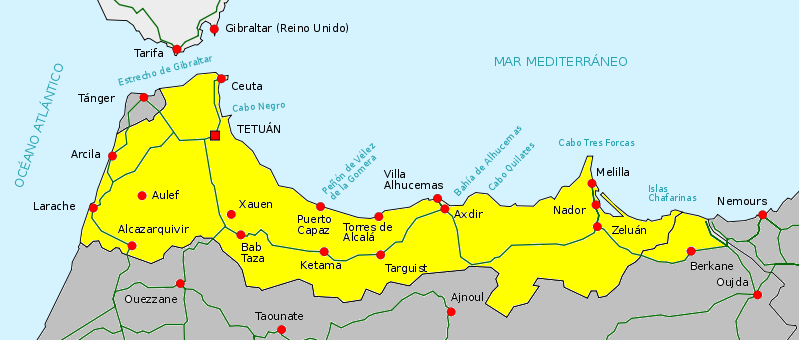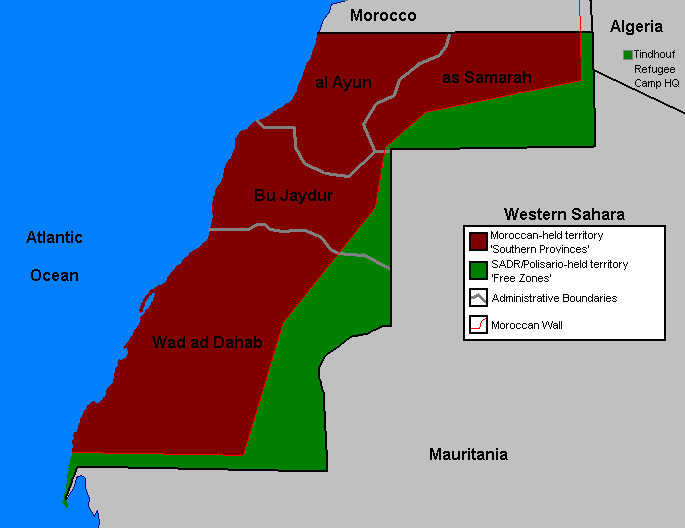|
Algeria–Morocco Border
The Algeria–Morocco border is 1,427 km (887 mi) in length and runs from Mediterranean Sea in the north, to the tripoint with Western Sahara in the south. The border has been officially closed to all travel since 1994, although clandestine crossings are common. Description The boundary starts in the north on the Mediterranean Sea just west of Marsa Ben M'Hidi; it then proceeds overland toward the south via a series of irregular lines, veering slightly to the southeast. Near the Moroccan town of Figuig it veers sharply to the west, proceeding then in a broadly south-westerly direction via a series of straight and irregular lines. Upon reaching the Draa River the border then follows this for some distance, before veering sharply to the south, whereupon a straight north–south line proceeds for 116 km (72 mi) down to the Western Sahara tripoint. History France occupied much of the northern coastal areas of Algeria in the period 1830–47, which had hitherto ... [...More Info...] [...Related Items...] OR: [Wikipedia] [Google] [Baidu] |
Tangier International Zone
The Tangier International Zone (; ; ) was a international zone centered on the city of Tangier, Morocco, which existed from 1925 until its reintegration into independent Morocco in 1956, with interruption during the Spanish occupation of Tangier (1940–1945), and special economic status extended until early 1960. Surrounded on the land side by the Spanish protectorate in Morocco, it was governed under a unique and complex system that involved several European nations, the United States (mainly after 1945), and the Sultan of Morocco, himself under a French protectorate in Morocco, French protectorate. Due to its status as an international zone, Tangier played a crucial role for Moroccan nationalists, who wanted independence, to establish international contacts and recruit allies as well as organising gatherings and events. Background: early international governance in Tangier For nearly a century after the end of English Tangier, English rule in 1684, Tangier was primarily ... [...More Info...] [...Related Items...] OR: [Wikipedia] [Google] [Baidu] |
Oujda
Oujda (, ) is a major city in northeast Morocco near the Algeria–Morocco border, border with Algeria. Oujda is the capital city of the Oriental (Morocco), Oriental region of northeastern Morocco and has a population of 506,224 people (2024 census). It is located about west of the Algeria–Morocco border, Moroccan-Algerian border in the south of the Iznasen, Beni Iznassen Mountains and about south of the Mediterranean Sea, Mediterranean coast. History Origins There is some evidence of a settlement during the Roman occupation, which seems to have been under the control of Berbers rather than Romans. The city was founded in 994 by Ziri ibn Atiyya, Berber chief of the Zenata Maghrawa tribe. Ziri was, with his tribe, authorized to occupy the region of Fas, but feeling insecure in that region and that town, and wishing to be nearer to the central Maghrib homeland of his tribe, he moved to Oujda, installed there a garrison and his possessions, appointing one of his relatives as ... [...More Info...] [...Related Items...] OR: [Wikipedia] [Google] [Baidu] |
Ahfir
Ahfir () is a town in Berkane Province, Oriental (Morocco), Oriental, Morocco, adjacent the Algeria–Morocco border, border with Algeria. According to the 2004 census, it has a population of 19,482. The name Ahfir refers to the stone quarry which was exploited in this village founded by Hubert Lyautey at the time of the French protectorate. This village, which is inhabited by Beni Iznassen, was the gateway to the French conquest of Morocco, French invasion by Lyautey in 1907 leading to the imposition of the French protectorate from 1912 until 1956. The name Ahfir means "Hole" in Berberized Arabic and would refer either to the great Trench, war trenches that were dug in this territory located near the Moroccan-Algerian border before the construction of the city by Hubert Lyautey, or to the Quarry, stone quarry that was exploited in this village at the time of the French protectorate in Morocco, French protectorate (Martimprey-du-Kiss). References Populated places in Berkane ... [...More Info...] [...Related Items...] OR: [Wikipedia] [Google] [Baidu] |
Béni Ounif
Béni Ounif is a town and commune in Béchar Province, Algeria, coextensive with the ''district'' of Béni Ounif. It has a population of 10,732 as of the 2008 census, up from 8,199 in 1998, and had an annual growth rate of 2.8%, the second highest in the province. The commune covers an area of . History The ''Béni Ounif massacre'' took place in the commune near the Moroccan border, on 15 August 1999. Guerrillas stopped a bus at a fake roadblock and killed some 29 people. President Abdelaziz Bouteflika suggested that the terrorists in question had found shelter in Morocco, but later retracted the accusation. The Moroccan Interior Minister Driss Basri denied the allegations. Geography Béni Ounif lies at an elevation of on the Oued Zouzfana downstream of Figuig. To the south the landscape is mostly flat, with a few small hills, while to the north there is a range of taller, rocky hills running from west to east along the Algeria–Morocco border. Aside from the river valleys ... [...More Info...] [...Related Items...] OR: [Wikipedia] [Google] [Baidu] |
Forthassa Gharbia
Forthassa Gharbia (or Forthassa Rharbia) is a small settlement in western Algeria near the Moroccan border, to the west of Aïn Séfra. During the French colonial era it was important as a military post. Forthassa Gharbia is a waterhole on the High Plateaux between the Tell and Saharan Atlas ranges. It lies slightly to the west of a line between Teniet el Sassi and the oasis of Ich, and therefore was technically within Moroccan territory, but in 1904 the boundary between Morocco and Algeria had not been delimited in this region, and there was no protest when the French occupied it. The French advance post at Forthassa Gharbia was established in March 1904 by Hubert Lyautey to ensure that the Beni Guil, a Moroccan tribe, accepted French rule. The post closed the dangerous pass of Jebel Grouz, cutting off the Beni Guil from their allies. By 1904 the pacification had mostly been achieved with little need for fighting. For some time after establishing their protectorate over Moro ... [...More Info...] [...Related Items...] OR: [Wikipedia] [Google] [Baidu] |
Algerian Civil War
The Algerian Civil War (), known in Algeria as the Black Decade (, ), was a civil war fought between the Algerian government and various Islamist rebel groups from 11 January 1992 (following a 1992 Algerian coup d'état, coup negating an Islamist electoral victory) to 8 February 2002. The war began slowly, as it initially appeared the government had successfully crushed the Islamist movement, but armed groups emerged to declare jihad and by 1994, violence had reached such a level that it appeared the government might not be able to withstand it. By 1996–97, it had become clear that the Islamist resistance had lost its popular support, although fighting continued for several years after.#GKJTPI2002, Kepel, ''Jihad'', 2002: p.255 The war has been referred to as 'the dirty war' (''la sale guerre''), and saw extreme violence and brutality used against civilians.#GKJTPI2002, Kepel, ''Jihad'', 2002: p.254 List of Algerian assassinated journalists, Islamists targeted journalists, ov ... [...More Info...] [...Related Items...] OR: [Wikipedia] [Google] [Baidu] |
Federal Research Division
The Federal Research Division (FRD) is the research and analysis unit of the United States Library of Congress. The Federal Research Division provides directed research and analysis on domestic and international subjects to agencies of the United States government, the District of Columbia, and authorized federal contractors. As expert users of the vast English and foreign-language collections of the Library of Congress, the Division's area and subject specialists employ the resources of the world's largest library and other information sources worldwide to produce impartial and comprehensive studies on a cost-recovery basis. The Federal Research Program is run by the Federal Research Division (FRD), the fee-for-service research and analysis unit within the Library of Congress. The Federal Research Program of the Library of Congress was authorized by the United States Congress in accordance with the Library of Congress Fiscal Operations Improvement Act of 2000 (2 U.S.C. 182c). FR ... [...More Info...] [...Related Items...] OR: [Wikipedia] [Google] [Baidu] |
Library Of Congress
The Library of Congress (LOC) is a research library in Washington, D.C., serving as the library and research service for the United States Congress and the ''de facto'' national library of the United States. It also administers Copyright law of the United States, copyright law through the United States Copyright Office, and it houses the Congressional Research Service. Founded in 1800, the Library of Congress is the oldest Cultural policy of the United States, federal cultural institution in the United States. It is housed in three buildings on Capitol Hill, adjacent to the United States Capitol, along with the National Audio-Visual Conservation Center in Culpeper, Virginia, and additional storage facilities at Fort Meade, Fort George G. Meade and Cabin Branch in Hyattsville, Maryland. The library's functions are overseen by the librarian of Congress, and its buildings are maintained by the architect of the Capitol. The LOC is one of the List of largest libraries, largest libra ... [...More Info...] [...Related Items...] OR: [Wikipedia] [Google] [Baidu] |
Polisario Front
The Popular Front for the Liberation of Saguia el-Hamra and Río de Oro (Spanish language, Spanish: ; ), better known by its acronym Polisario Front, is a Sahrawi nationalism, Sahrawi nationalist liberation movement seeking to end the occupation of Western Sahara through the means of self-determination and Wars of national liberation, armed resistance. Tracing its origin to a Sahrawi nationalist organization known as the Movement for the Liberation of Saguia el Hamra and Wadi el Dhahab, the Polisario Front was formally constituted in 1973 with the intention of launching an armed struggle against the Spanish Sahara, Spanish occupation which lasted until 1975, when the Spanish decided to allow Mauritania and Morocco to partition and occupy the territory. The Polisario Front proclaimed the Sahrawi Arab Democratic Republic (SADR) on 27 February 1976, and Western Sahara War, waged a war to drive out the two armies. It forced Mauritania to relinquish its claim over Western Sahara in ... [...More Info...] [...Related Items...] OR: [Wikipedia] [Google] [Baidu] |
Spanish Sahara
Spanish Sahara (; ), officially the Spanish Possessions in the Sahara from 1884 to 1958, then Province of the Sahara between 1958 and 1976, was the name used for the modern territory of Western Sahara when it was occupied and ruled by Spain between 1884 and 1976. It had been one of the most recent acquisitions as well as one of the last remaining holdings of the Spanish Empire, which had once extended from the Americas to the Spanish East Indies. Between 1946 and 1958, the Spanish Sahara was amalgamated with the nearby Spanish-protected Cape Juby and Spanish Ifni to form a new colony, Spanish West Africa. This was reversed during the Ifni War when Ifni and the Sahara became provinces of Spain separately, two days apart, while Cape Juby was ceded to Morocco in the peace deal. Spain gave up its Saharan possession following Moroccan demands and international pressure, mainly from United Nations resolutions regarding decolonisation. There was internal pressure from the native ... [...More Info...] [...Related Items...] OR: [Wikipedia] [Google] [Baidu] |
Sand War
The Sand War () was a border conflict between Algeria and Morocco fought from September 25 to October 30, 1963, although a formal peace treaty was not signed until February 20, 1964. It resulted largely from the Moroccan government's claim to portions of Algeria's Tindouf and Béchar provinces. The Sand War led to heightened tensions between the two countries for several decades. Full-blown confrontation began on September 25, 1963, once Moroccan forces occupied the border towns of Hassi Beida and Tindjoub, beginning a battle with Algerian forces for control over the towns. In the north, Algeria opened a front near Ich, while Morocco launched an offensive towards Tindouf in the south. Cuban troops arrived in Algeria to prepare for an offensive into eastern Morocco, prompting Morocco to prepare for a second offensive towards Tindouf. However, both attacks were suspended, and a ceasefire was officially declared on October 30, 1963. This ceasefire marked the first multinational ... [...More Info...] [...Related Items...] OR: [Wikipedia] [Google] [Baidu] |






